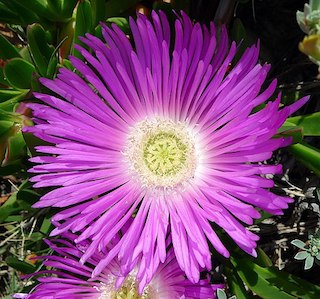 The bright pink and yellow flowers of Hottentot-fig look cheerful on sea cliffs in the summer, but this is an introduced and invasive species.
The bright pink and yellow flowers of Hottentot-fig look cheerful on sea cliffs in the summer, but this is an introduced and invasive species.
Photo: Gail Hampshire (Wikimedia Commons)
Scientific name: Carpobrotus edulis
Other common names: Ice plant,Sally-my-handsome
What to look for:
- Flowers: Up to 10 cm across, with many pink or yellow petals and a large head of yellow stamens
- Leaves: Fleshy, narrow and triangular, arranged in opposite pairs along the creeping woody stems
- Length: Plants can spread for many metres
- Where: Introduced from South Africa, it can be found on sea cliffs in southwest England and Ireland
- When: Flowers from April to July
- Habit: Creeping, forming dense and large mats
 It’s hard to feel unkindly towards Hottentot-fig when its mass of pink and yellow flowers are blooming over the cliffs of the Lizard in a dazzling display. This is, however, an introduced and invasive plant that does our native flora no good at all. Originally from South Africa, Hottentot-fig’s mat-forming, spreading habit blankets sea cliffs in parts of the south-west, crowding out native plants which are unable to compete. Able to grow at a rate of up to 1 m per year, this frost-sensitive plant can quickly become established and spread in areas where the climate is milder.
It’s hard to feel unkindly towards Hottentot-fig when its mass of pink and yellow flowers are blooming over the cliffs of the Lizard in a dazzling display. This is, however, an introduced and invasive plant that does our native flora no good at all. Originally from South Africa, Hottentot-fig’s mat-forming, spreading habit blankets sea cliffs in parts of the south-west, crowding out native plants which are unable to compete. Able to grow at a rate of up to 1 m per year, this frost-sensitive plant can quickly become established and spread in areas where the climate is milder.
Did you know…?
…Hottentot-fig was introduced to Britain from South Africa in the seventeenth century, and was first recorded in the wild in the nineteenth century.
…The plant produces fruit (the figs), but our climate is not warm enough for them to ripen and be edible.
More information and references:
Mabey, R., 1997. Flora Britannica. Chatto & Windus, London.
Rose, F. and O’Reilly, C., 2006. The Wild Flower Key, 2nd edition. Frederick Warne, London.
Published: June 2014
Author: Amanda Scott
Photos: Gail Hampshire via Wikimedia Commons
